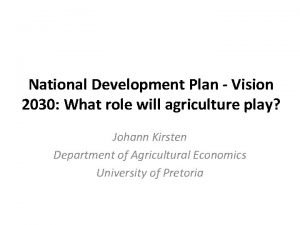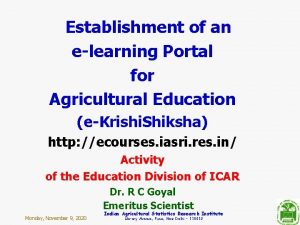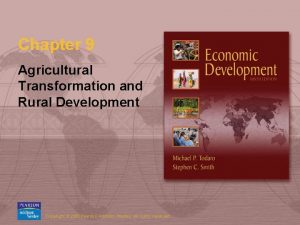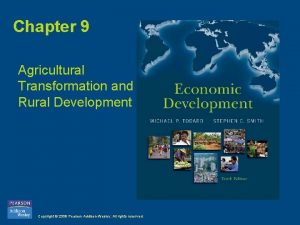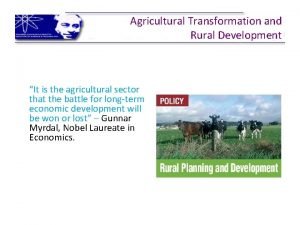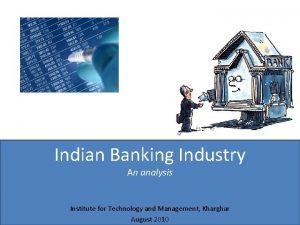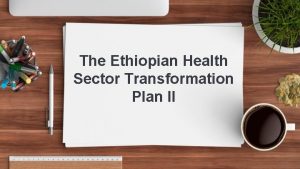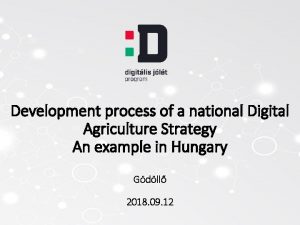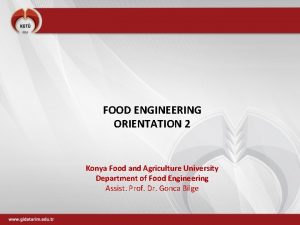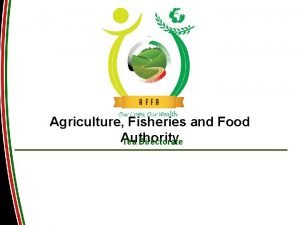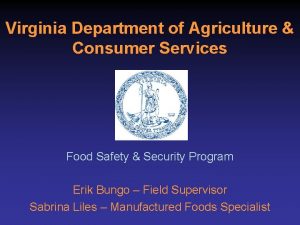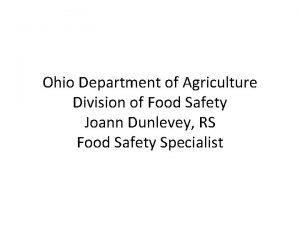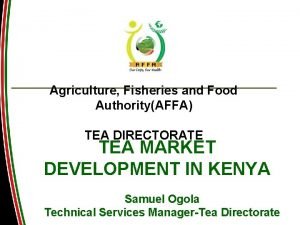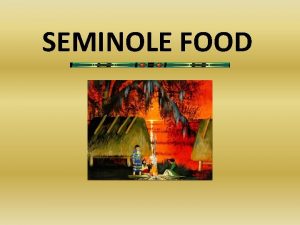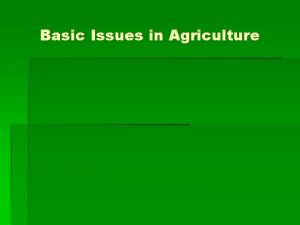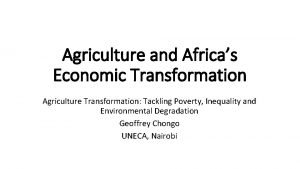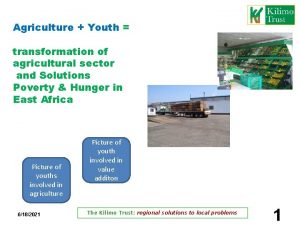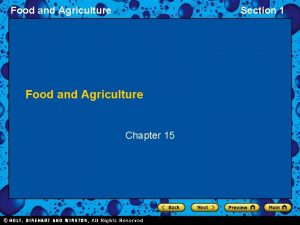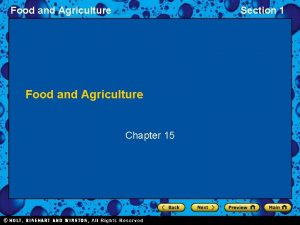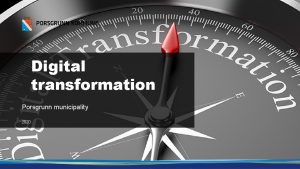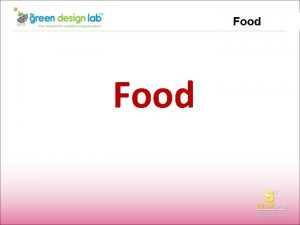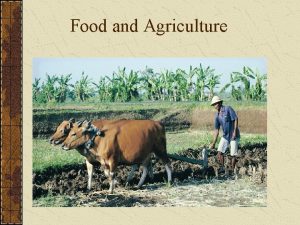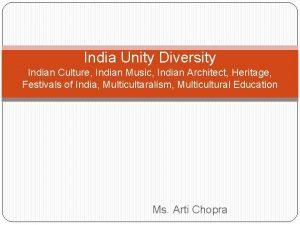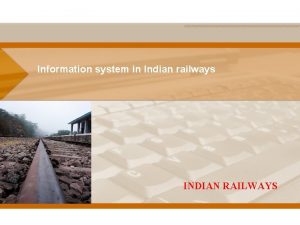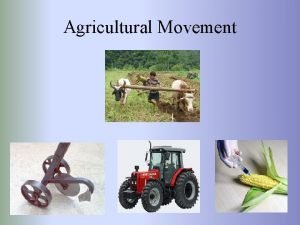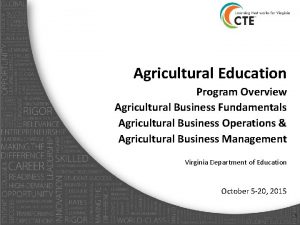Digital Transformation in Agriculture Indian Agricultural Sector Food

















- Slides: 17

Digital Transformation in Agriculture

Indian Agricultural Sector § Food grain surplus yet high wastage. § 80% of the population lives in rural areas and depends on agricultural production. § Urgent need to diversify agriculture to address emerging food demands and habits, and dietary problems. § Need for climate smart agri-technologies to tackle climate change issues. § Opportunities to improve productivity along value chain. § Increased presence of private sector in both input and output markets. § Need to produce both economically efficient & environmentally friendly technologies to tap the opportunities for export.

Agriculture is a risky enterprise – can digital help Weather Labour Production Risk Knowledge Quality Inputs Agriculture Risk Post Harvest Risks Market Risk Ecological Risk • Climate Change will cause more uncertainty • Mechanization mitigates labour shortage but funding is constrained. • Traditional Agriculture extension systems are inadequate and lack depth to help farmers deal with exigencies like pests, disease etc • Timely access to quality seeds and fertilizers is still unreliable Access to Credit • Most farmers lack access to structured credit markets making them a prey for the money lenders Storage • India loses about one third farm produce for want of quality storage Market Information Access to Market Price Volatility • High levels of Information asymmetry due to variety of reasons • Access to markets is still a challenge due to high transportation costs • Price Volatility tends to benefit only speculators Limited Land • Rapidly degrading land soil health pose a challenge to ecology and future productivity. Limited Water • Declining Ground water table and erratic rainfall poses a serious challenge to reliable source of water for irrigation Digital tools offer pathways to mitigate agriculture risk

Porter’s Value Chain Framework Land, Water, Machinery, etc • Corporate success driven by linkages • Linkages are about seamless cooperation and information flow • Most often, an ecosystem of companies works across the value chain • Challenges for farm as an ag enterprise • All primary value chain activities other than operations are dispersed across public and private institutions • This leads to a weak bargaining position • Many variables within operations/production Eg. Weather • Technology Development/R&D mostly through public institutions Self, Family, Farm Labour SAUs, Public Institutions, private sector Govts, Agriculture Dept Competitive Advantage by Porter (1985) Farmer Private Sector Government Consumers Research

Canvas for ICTs 4 Ag Peer to Peer collaboration platforms Research 2 Farmer (R 2 F) • • • Information Extension Learning platforms FPO management software Extension Systems KVKs NGOs • Distribution Channels Government 2 Farmer (G 2 F) Federal vs State Multiple Departments Subsidies • • Ag Marketing Structures Knowledge Intermediaries • • • Farmers 2 Consumers (F 2 C) Government Departments Private 2 Farmer (P 2 F) Mostly input companies – fertilizers, seed, pesticides companies • ICT enabled innovation happening -Evolutionary & revolutionary • Knowledge seen as a means to build customer loyalty • Operations • • • Precision farming Irrigation Automation Data driven farming Lot of ICT innovation Market linkages is a very broad term – processor, aggregator, retailer, end customer New business models emerging – ICT is a critical enabler

ICT enabled Innovation Spectrum Disruption (Revolutionary) Digitization (evolutionary) • Mainly three themes ‒ Disintermediation ‒ Uberization ‒ Expert Systems – AI, ML and Big Data • Disintermediation and Uberization drive impact business transactions • Expert systems enable computers impacts human computer interaction – offers mass customization • Digitization of supply chain ‒ No structural changes Personalized/ Dynamic/ Static digital Interactive Consumable Content/ Knowledge Content Contextualized/ Insights Driven • Foundational for Decision Support Systems (DSS) • On farm management tools possible only if this is available • IOTs • Plot level aerial imagery • Analytics Personalization • Investment needed in making content dynamic and consumable – knowledge engineering

Why do Innovation and Entrepreneurship Matter? Drivers of Prosperity Innovation Entrepreneurship: The creation and growth of new businesses (start-ups per adult population) Entrepreneurship “Knowledge. Based” Entrepreneurs Economic Growth Innovation: The process of creating new goods and services that provide unique value for demanding customers who are willing to pay for that value I+E increase the rate of economic growth Time Innovation and entrepreneurship create prosperity by: • • “Invention and entrepreneurship are at the heart of national advantage” Increasing wages by competing on human capital and knowledge Reducing unemployment - M. Porter Connecting local economies to the global economy Source: Audretsch, D. B. and R. Thurik, “Linking Entrepreneurship to Growth, ” OECD Facilitating clusters and knowledge transfer Science, Technology and Industry Working Papers, 2001/2

Innovation Definition Problem Recognition Problem solving Invention Solution Exploitation Innovation pipeline Innovation

A new paradigm to do digital agriculture Agri-entrepreneurship can : Attract youth to agriculture Foster entrepreneurship spirit and help increase incomes ICRISAT ihub launched on February 13, 2017 to accelerate opportunities for agri-preneurs in India

KALGUDI TITSC Intello Labs

Decision tree – Rainfed groundnut system, Anantapur Phase 1 (Sowing App) • Pilot in June 2016 focused only on Sowing date advisory in collaboration with Microsoft Hyderabad • This model projected the moisture adequacy index (MAI) using water balance technique based on weather forecast and outlook (IMD, IITM, a. Where). • MAI based logic used to trigger sowing date advisory to farmers. Phase 2 (isat) Timeline Conditions April&May LT Forecast Kharif Avg Rain=352 mm P for>350 mm=0. 44 Decision AN >350 mm Plant GN with PP as intercrop Any other options? ? Message • Plant GN at the earliest opportunity after 2 nd week of June • Plough the land, prepare the seed and apply FYM <350 mm • The current experiment tries to contextualize the Long Term forecasts for small holder farmers • Pre-season advisory from IMD, IITM, EFRS is being used to send season advisory • Great opportunity to build such systems for more crops and agro-ecologies and enable small holders for tactical management. • A good template for translating knowledge to actionable insights for farmers BN No Prepare for planting a mix of crops • Plant early maturing GN at the earliest opportunity • Plough the land, get the seed • Consider using a mix of crops Limited GN with high proportion of drought tolerant crops • Plant early maturing GN at the earliest opportunity • Plough the land, get the seed • Consider allocating about 2550% of the land to drought tolerant crops-Early maturing PP, Foxtail etc El Nino s, Ye Av 65 =2 RF mm

Conditions Next week forecast Week 1 Last week Rain >1 Met Date Weeks <1 0 m m Timeline 0 Next week forecast m 4 - 10 Jun 30 23 - 29 Jul 31 30 Jul - 5 Aug 32 6 Aug - 12 Aug 33 13 Aug - 19 Aug 37 10 Sep - 16 Sep 38 17 Sep - 23 Sep 39 24 Sep - 30 Sep 40 1 - 7 Oct Week 4 Next week forecast Last week Rain m 0 m 3 Sep - 9 Sep Next week forecast m 36 Last week Rain >1 27 Aug - 2 Sep Week 3 m 35 Next week forecast 0 20 Aug - 26 Aug Avg Rain=50 mm P for>20 mm=0. 73 >1 34 June Next week forecast m 16 - 22 Jul m 29 Last week Rain m 9 - 15 Jul Week 2 m 28 0 m 2 - 8 Jul >10 m Next week forecast m 2 week outlook mm 2 week outlook <10 mm 2 week outlook >10 mm mm <10 >10 2 week outlook mm <10 2 week outlook <1 27 m 24 Jun - 1 Jul <1 0 26 <1 0 18 - 24 Jun m 25 Next week forecast m 11 - 17 Jun 0 >1 24 m 23 m <10 m >10 mm mm <10 >10 2 week outlook mm 2 week outlook mm <10 2 week outlook >10 mm mm <10 2 week outlook BN AN BN AN Message Wait Prepare the land or Plant GN Prepare land Get ready for planting Prepare land Plant GN Wait Plant GN BN Wait AN Plant GN


ICRISAT – PEAT Collaboration Major partner on the ground Picture Acquisition Networking Governments & University PR & Marketing Farmer Workshops

ICRISAT – PEAT Collaboration • From about 10 k downloads in November 2016 to the present range of 100 k is a big leap due to our intervention • ICRISAT & PEAT will continue to collaborate to add more crops and pest & diseases to the library • ICRISAT will pursue plantix adoption with govts and farmers • PEAT, ICRISAT, CIMMYT consortium proposes to undertake pest/disease modelling which currently suffers from absence of high quality primary data

Thank You

Various Contexts of Agriculture Farming Agriculture Commerce Knowledge
 Vision 2030 agricultural sector plan
Vision 2030 agricultural sector plan Agri education portal
Agri education portal Chapter 9 agricultural transformation and rural development
Chapter 9 agricultural transformation and rural development Chapter 9 agricultural transformation and rural development
Chapter 9 agricultural transformation and rural development Agricultural transformation and rural development
Agricultural transformation and rural development Indian banking sector overview
Indian banking sector overview Health sector transformation plan ii ethiopia
Health sector transformation plan ii ethiopia Digital agriculture strategy
Digital agriculture strategy Unit 2 food food food
Unit 2 food food food Food chain food chain food chain
Food chain food chain food chain Konya food and agriculture university
Konya food and agriculture university Agriculture fisheries and food authority
Agriculture fisheries and food authority Virginia department of agriculture and consumer services
Virginia department of agriculture and consumer services Ohio cottage food law label
Ohio cottage food law label Ministry of food agriculture and fisheries denmark
Ministry of food agriculture and fisheries denmark Tea directorate
Tea directorate What did the seminoles eat
What did the seminoles eat Mississippian food
Mississippian food
